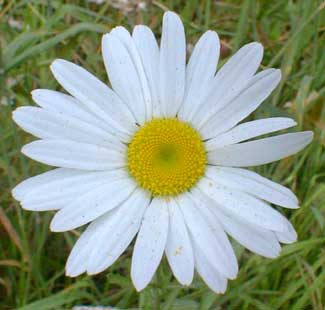
Oxeye Daisy
"In youth from rock to rock I went,
From hill to hill in discontent
Of pleasure high and turbulent,
Most pleased when most uneasy;
But now my own delights I make,--
My thirst at every rill can slake,
And gladly Nature's love partake,
Of Thee, sweet Daisy!"
-William Wordsworth
(1770-1850)
(1770-1850)
The beautiful oxeye or ox-eye daisy (Leucanthemum vulgareformerly Chrysanthemum leucanthemum) is probably the most familiar flower on earth, the model for just about every child's first flower drawing.
Though native to Eurasia, it has escaped from gardens world-wide. It is found from one coast of North America to the other, in many areas posing a threat to much less aggressive native wildflowers. It has naturalized often as a pest-plant in meadows, roadsides, railroad yards, forest edges, & has invaded fields of grain or hay.
In pastures it is liked by sheep & goats but cattle aren't as fond of it, so cattle ranches & dairies attempt to restrict its spread. Commony purchased in collections of wildflower seeds for random scattering, this practice is really to be abhored since oxeye daisy is difficult to control even without assisting its spread.
Such a widespread & pretty weed was bound to acquire a vast array of common names. It gets called White Daisy, White Weed, White Golds, Yellow Daisy, Goldens, Butter Daisy, Drummer Daisy, Button Daisy, Billy Button, Field Daisy, Sun Daisy, Open Stars, Harvest Daisy, Midsummer Daisy, Maudlin Daisy, Maudlinwort, Bruisewort, Gool, Grande Marguarite, Herb Margaret, Priest's Collar, Dutch-cuss, Dutch Curse, Dutch Morgan, Crazy Bet, Fried Eggs, Fair Maids of France, Grandmothers, Bishop's Posy, Bozzom, Poverty Weed, or Poorland Daisy.
The names Dun Daisy, Dunder Daisy, Dundle Daisy, Thunder Daisy, & Harvest Daisy are after the cthonic harvest god Dun or Donn, a green man figure & a reflex of Odin as ruler of rocky coastal islands where little would grow, apart from daisies. The daisy is similarly called Balder's Brow after the god of light & joy. Drummer Daisy is a corruption of the poetic edda Baldrs draumar (Balder's Dreams). Very likely such names as Ox-eye Daisy, Cow Eyes, Bull's Daisy, Bull's-eye Daisy refer to Balder's parents Odin & Frigga, for cattle were one of Odin's gifts to humanity, or else Thor & Freya who sometimes had the form of bull & cow.
The traditional "daisy pancake" still made by Norwegians harks back to this recurring association with a Teutonic or Scandinavian divine family, who inspired the very name Daisy, or Day's Eye, as Odin was frequently depicted as having only one eye, the other having been sacrified in order to drink from the well of wisdom.
The eight-legged horse Sleipnir, the stallion of both Balder & Odin, is remembered in such names as Horse Daisy, Horse Gowan, Horse Pennies, & Horse Blobs. The name White Gull may well recall Gulltop, a horse of Norse mythology who was white with golden mane, & whose name means "gold maned" or "golden crested."
Dog Blow, Dogflower, or Dog Daisy recalls Odin's giant four-eyed dog Garm who guarded the entry of Hell, but who also brought the rain. The association with the Hell-hound may relate to the name Devil's Daisy, & daisies to this day carry associations with the land of the dead, with the daisy-like Tanacetums being literally named for Thanatos.
Frigga or Freya as Moon-goddess, & Nanna (Balder's wife, the Soul of the Moon), provided the common names Moonflower, Moon-penny, Moons, or Moon's Eye, & this association was transferred to sundry Artemis-like huntress-goddesses wherever daisies grew, until Christians coopted it as a symbol of Mary Magdalene.
Some say the names Maudlin Daisy or Maudlinwort are corrupted from Magdalene, but this may be one stretch too far. Daisies were brewed as a calming tea akin to chamomile, to sooth nervous disorders including depression, hence it was the herb (wort) used to cure unhappiness (maudlin). It was powerfully associated with women, the Mother Goddess, the moon, & "hysteria" (literally "of the womb"), because used as an antispasmodic in treating menstrual cramps.
Here on the Kitsap Penninsula wild oxeye daisies flower primarily in summer, especially in August, though further south it blooms much of spring as well. The flowers stand two or three feet tall; the basal growth is largely prostrate, spreading along creeping rootstock.